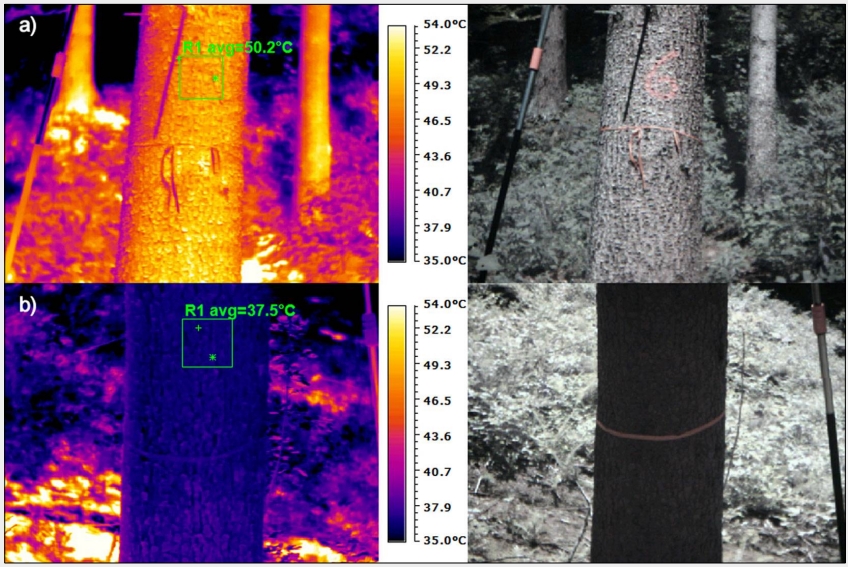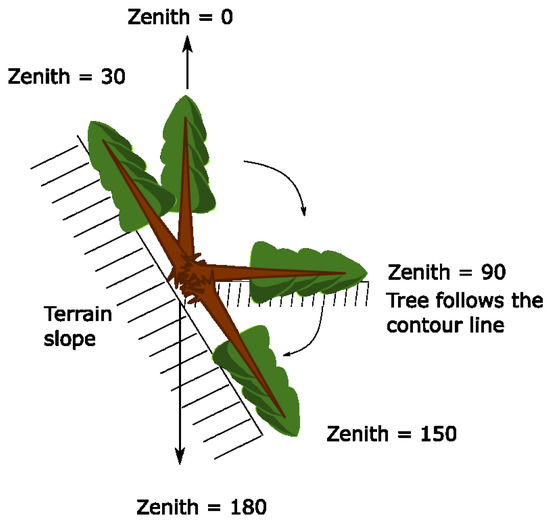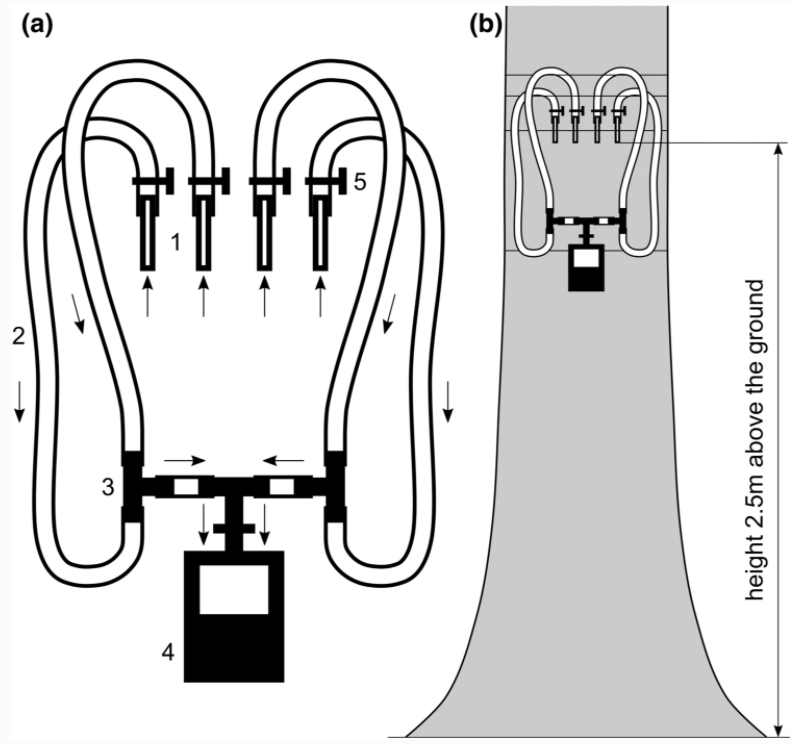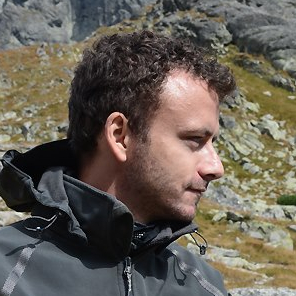2024
|
 | Šamajová, Veronika; Marešová, Jana; Majdák, Andrej; Jakuš, Rastislav; Blaženec, Miroslav The spruce bark volatiles and internal phloem chemical profiles after the forest gap formation: the annual course Journal Article Folia Oecologica, 51 (2), pp. 165–174, 2024, ISSN: 1338-7014. Abstract | Links | BibTeX @article{_amajov__2024,
title = {The spruce bark volatiles and internal phloem chemical profiles after the forest gap formation: the annual course},
author = {Veronika Šamajová and Jana Marešová and Andrej Majdák and Rastislav Jakuš and Miroslav Blaženec},
url = {http://ife.sk/wp-content/uploads/2020/09/foecol-2024-0016.pdf},
doi = {10.2478/foecol-2024-0016},
issn = {1338-7014},
year = {2024},
date = {2024-07-01},
journal = {Folia Oecologica},
volume = {51},
number = {2},
pages = {165–174},
publisher = {Walter de Gruyter GmbH},
abstract = {Our study explores the impact of sudden gap formation on the bark volatile and internal chemical profiles of Norway spruce trees during the initial dry year of research plot 2018 following gap formation. We investigated the annual variation in two main physiological traits of Norway spruce trees at the forest edge (FE) and in the forest interior (FI): bark monoterpene (MT) emission spectra and internal phloem MT composition. Given that gap formation increases the solar radiation dose and temperature for trees at the forest edge, we hypothesized that the concentrations of airborne terpenes released from the tree bark and internal phloem terpenes will increase as a consequence of induced tree defenses. Our findings demonstrate significant increases in both airborne terpene concentrations and internal terpene composition in trees at the forest edge compared to the control trees in the forest interior. This study provides novel insights into the annual dynamics of bark monoterpenes following forest edge establishment and underscores the physiological changes experienced by trees in response to the gap formation.},
keywords = {},
pubstate = {published},
tppubtype = {article}
}
Our study explores the impact of sudden gap formation on the bark volatile and internal chemical profiles of Norway spruce trees during the initial dry year of research plot 2018 following gap formation. We investigated the annual variation in two main physiological traits of Norway spruce trees at the forest edge (FE) and in the forest interior (FI): bark monoterpene (MT) emission spectra and internal phloem MT composition. Given that gap formation increases the solar radiation dose and temperature for trees at the forest edge, we hypothesized that the concentrations of airborne terpenes released from the tree bark and internal phloem terpenes will increase as a consequence of induced tree defenses. Our findings demonstrate significant increases in both airborne terpene concentrations and internal terpene composition in trees at the forest edge compared to the control trees in the forest interior. This study provides novel insights into the annual dynamics of bark monoterpenes following forest edge establishment and underscores the physiological changes experienced by trees in response to the gap formation. |
2022
|
 | Jakuš, Rastislav; Modlinger, Roman; Kašpar, Jaroslav; Majdák, Andrej; Blaženec, Miroslav; Korolyova, Nataliya; Jirošová, Anna; Schlyter, Fredrik Testing the Efficiency of the Push-and-Pull Strategy during Severe Ips typographus Outbreak and Extreme Drought in Norway Spruce Stands Journal Article Forests, 13 (12), pp. 2175, 2022, ISSN: 1999-4907. Links | BibTeX @article{Jaku__2022,
title = {Testing the Efficiency of the Push-and-Pull Strategy during Severe Ips typographus Outbreak and Extreme Drought in Norway Spruce Stands},
author = {Rastislav Jakuš and Roman Modlinger and Jaroslav Kašpar and Andrej Majdák and Miroslav Blaženec and Nataliya Korolyova and Anna Jirošová and Fredrik Schlyter},
url = {http://dx.doi.org/10.3390/f13122175},
doi = {10.3390/f13122175},
issn = {1999-4907},
year = {2022},
date = {2022-01-01},
journal = {Forests},
volume = {13},
number = {12},
pages = {2175},
publisher = {MDPI AG},
keywords = {},
pubstate = {published},
tppubtype = {article}
}
|
 | Soukhovolsky, Vladislav; Kovalev, Anton; Tarasova, Olga; Modlinger, Roman; Křenová, Zdenka; Mezei, Pavel; Škvarenina, Jaroslav; Rožnovský, Jaroslav; Korolyova, Nataliya; Majdák, Andrej; Jakuš, Rastislav Wind Damage and Temperature Effect on Tree Mortality Caused by Ips typographus L.: Phase Transition Model Journal Article Forests, 13 (2), pp. 180, 2022, ISSN: 1999-4907. Links | BibTeX @article{Soukhovolsky_2022,
title = {Wind Damage and Temperature Effect on Tree Mortality Caused by Ips typographus L.: Phase Transition Model},
author = {Vladislav Soukhovolsky and Anton Kovalev and Olga Tarasova and Roman Modlinger and Zdenka Křenová and Pavel Mezei and Jaroslav Škvarenina and Jaroslav Rožnovský and Nataliya Korolyova and Andrej Majdák and Rastislav Jakuš},
url = {http://dx.doi.org/10.3390/f13020180},
doi = {10.3390/f13020180},
issn = {1999-4907},
year = {2022},
date = {2022-01-01},
journal = {Forests},
volume = {13},
number = {2},
pages = {180},
publisher = {MDPI AG},
keywords = {},
pubstate = {published},
tppubtype = {article}
}
|
2021
|
 | Majdák, Andrej; Jakuš, Rastislav; Blaženec, Miroslav Determination of differences in temperature regimes on healthy and bark-beetle colonised spruce trees using a handheld thermal camera Journal Article iFOREST, 14 , pp. 203-211, 2021, ISSN: 1971-7458. Abstract | Links | BibTeX @article{Majdák2021,
title = {Determination of differences in temperature regimes on healthy and bark-beetle colonised spruce trees using a handheld thermal camera},
author = {Andrej Majdák and Rastislav Jakuš and Miroslav Blaženec},
doi = {https://doi.org/10.3832/ifor3531-014},
issn = {1971-7458},
year = {2021},
date = {2021-05-02},
journal = {iFOREST},
volume = {14},
pages = {203-211},
abstract = {In this study, we compared the daily temperature regimes of healthy uninfected trees in the interior of a forest stand and at the fresh forest edge with infested trees at the forest edge in an area affected by a bark beetle outbreak. We estimated the potential of a handheld thermal camera for early identification of bark-beetle infested trees. We show that infested trees have significantly higher trunk temperatures than uninfested trees, which is more visible on the shine side of the trunk, and we report the differences in temperature between the shine and shadow sides. The differences are more noticeable on a warm, bright, and sunny day than on cold and cloudy day. The different intensity of solar radiation does not affect the distinction between infested and uninfested trees. The handheld thermal camera shows potential for identifying bark-beetle infested trees by scanning tree trunks on bright sunny days.},
keywords = {},
pubstate = {published},
tppubtype = {article}
}
In this study, we compared the daily temperature regimes of healthy uninfected trees in the interior of a forest stand and at the fresh forest edge with infested trees at the forest edge in an area affected by a bark beetle outbreak. We estimated the potential of a handheld thermal camera for early identification of bark-beetle infested trees. We show that infested trees have significantly higher trunk temperatures than uninfested trees, which is more visible on the shine side of the trunk, and we report the differences in temperature between the shine and shadow sides. The differences are more noticeable on a warm, bright, and sunny day than on cold and cloudy day. The different intensity of solar radiation does not affect the distinction between infested and uninfested trees. The handheld thermal camera shows potential for identifying bark-beetle infested trees by scanning tree trunks on bright sunny days. |
2020
|
 | Hroššo, Branislav; Mezei, Pavel; Potterf, Mária; Majdák, Andrej; Blaženec, Miroslav; Korolyova, Nataliya; Jakuš, Rastislav Drivers of Spruce Bark Beetle (Ips typographus) Infestations on Downed Trees after Severe Windthrow Journal Article Forests, 11 , 2020, ISSN: 1999-4907. Abstract | Links | BibTeX @article{Hroššo2020,
title = {Drivers of Spruce Bark Beetle (\textit{Ips typographus}) Infestations on Downed Trees after Severe Windthrow},
author = {Branislav Hroššo and Pavel Mezei and Mária Potterf and Andrej Majdák and Miroslav Blaženec and Nataliya Korolyova and Rastislav Jakuš},
doi = {10.3390/f11121290},
issn = {1999-4907},
year = {2020},
date = {2020-11-30},
journal = {Forests},
volume = {11},
abstract = {Research Highlights: Bark beetles are important agents of disturbance regimes in temperate forests, and specifically in a connected wind-bark beetle disturbance system. Large-scale windthrows trigger population growth of the European spruce bark beetle (Ips typographus L.) from endemic to epidemic levels, thereby allowing the killing of Norway spruce trees over several consecutive years. Background and Objectives: There is a lack of evidence to differentiate how outbreaks are promoted by the effects of environmental variables versus beetle preferences of trees from endemic to outbreak. However, little is known about how individual downed-tree characteristics and local conditions such as tree orientation and solar radiation affect beetle colonization of downed trees. Materials and Methods: To answer this question, we investigated the infestation rates and determined tree death categories (uprooted, broken, and stump) in wind-damaged areas in Western Tatra Mts. in Carpathians (Slovakia) from 2014–2016, following a windthrow in May 2014. In total, we investigated 225 trees over eight transects. For every tree, we measured its morphological (tree height, crown characteristics), environmental (solar radiation, terrain conditions, trunk zenith), temporal (time since wind damage), and beetle infestation (presence, location of attack, bark desiccation) parameters. We applied Generalized Additive Mixed Models (GAMM) to unravel the main drivers of I. typographus infestations. Results: Over the first year, beetles preferred to attack broken trees and sun-exposed trunk sides over uprooted trees; the infestation on shaded sides started in the second year along with the infestation of uprooted trees with lower desiccation rates. We found that time since wind damage, stem length, and incident solar radiation increased the probability of beetle infestation, although both solar radiation and trunk zenith exhibited nonlinear variability. Our novel variable trunk zenith appeared to be an important predictor of bark beetle infestation probability. We conclude that trunk zenith as a simple measure defining the position of downed trees over the terrain can anticipate beetle infestation. Conclusions: Our findings contribute to understanding of the bark beetle’s preferences to colonize windthrown trees in the initial years after the primary wind damage. Further, our findings can help to identify trees that are most susceptible to beetle infestation and to prioritize management actions to control beetle population while maintaining biodiversity.},
keywords = {},
pubstate = {published},
tppubtype = {article}
}
Research Highlights: Bark beetles are important agents of disturbance regimes in temperate forests, and specifically in a connected wind-bark beetle disturbance system. Large-scale windthrows trigger population growth of the European spruce bark beetle (Ips typographus L.) from endemic to epidemic levels, thereby allowing the killing of Norway spruce trees over several consecutive years. Background and Objectives: There is a lack of evidence to differentiate how outbreaks are promoted by the effects of environmental variables versus beetle preferences of trees from endemic to outbreak. However, little is known about how individual downed-tree characteristics and local conditions such as tree orientation and solar radiation affect beetle colonization of downed trees. Materials and Methods: To answer this question, we investigated the infestation rates and determined tree death categories (uprooted, broken, and stump) in wind-damaged areas in Western Tatra Mts. in Carpathians (Slovakia) from 2014–2016, following a windthrow in May 2014. In total, we investigated 225 trees over eight transects. For every tree, we measured its morphological (tree height, crown characteristics), environmental (solar radiation, terrain conditions, trunk zenith), temporal (time since wind damage), and beetle infestation (presence, location of attack, bark desiccation) parameters. We applied Generalized Additive Mixed Models (GAMM) to unravel the main drivers of I. typographus infestations. Results: Over the first year, beetles preferred to attack broken trees and sun-exposed trunk sides over uprooted trees; the infestation on shaded sides started in the second year along with the infestation of uprooted trees with lower desiccation rates. We found that time since wind damage, stem length, and incident solar radiation increased the probability of beetle infestation, although both solar radiation and trunk zenith exhibited nonlinear variability. Our novel variable trunk zenith appeared to be an important predictor of bark beetle infestation probability. We conclude that trunk zenith as a simple measure defining the position of downed trees over the terrain can anticipate beetle infestation. Conclusions: Our findings contribute to understanding of the bark beetle’s preferences to colonize windthrown trees in the initial years after the primary wind damage. Further, our findings can help to identify trees that are most susceptible to beetle infestation and to prioritize management actions to control beetle population while maintaining biodiversity. |
 | Marešová, Jana; Majdák, Andrej; Jakuš, Rastislav; Hradecký, Jaromír; Kalinová, Blanka; Blaženec, Miroslav The short-term effect of sudden gap creation on tree temperature and volatile composition profiles in a Norway spruce stand Journal Article Trees-Structure and Function, 34 (6), pp. 1397–1409, 2020, ISSN: 0931-1890. Abstract | Links | BibTeX @article{Marešová2020,
title = {The short-term effect of sudden gap creation on tree temperature and volatile composition profiles in a Norway spruce stand},
author = {Jana Marešová and Andrej Majdák and Rastislav Jakuš and Jaromír Hradecký and Blanka Kalinová and Miroslav Blaženec},
doi = {10.1007/s00468-020-02010-w},
issn = {0931-1890},
year = {2020},
date = {2020-08-05},
journal = {Trees-Structure and Function},
volume = {34},
number = {6},
pages = {1397–1409},
abstract = {Spruce bark beetles are likely to attack trees that are at newly opened forest edges after wind disturbance due to higher temperatures and higher emission of primary attractants. The mechanisms behind these phenomena are still not fully known. We investigated how sudden gap creation affects tree physiology parameters related to induced defence processes in Norway spruce trees 2 months after the disturbance driven gap formation. We hypothesized that the sudden sun exposure of mature spruce trees would increase: (1) bark and crown temperatures, (2) sap flow rates, and (3) the phloem and airborne concentration of terpenes. Using a terrestrial and airborne thermal camera, sap flow sensors, and chromatography, we confirmed that trees at the forest edge had significantly higher (1) mean tree crown temperature, (2) mean sap flow rates (2-fold higher) and (3) airborne concentration of α-pinene (αP, 12.2-fold higher) and β-pinene (βP, 7.9-fold higher) close to the bark. We observed a significant positive correlation (R2 = 0.77) between the measured sap flow rates and terpene concentrations in airborne samples. Bark temperatures were not significant. In the phloem samples, analyzed by GC–MS, αP and βP predominated over monoterpenes 3-carene, myrcene, limonene, 1.8-cineole, and bornyl acetate. GC × GC–TOF–MS analysis of phloem showed a higher relative abundance of resin acid methyl esters in the forest interior trees and higher relative abundances of dehydro-p-cymene in the trees at the forest edge. Our findings are discussed in the context of the enhanced predisposition of trees at the newly formed forest edge to bark beetles attack.},
keywords = {},
pubstate = {published},
tppubtype = {article}
}
Spruce bark beetles are likely to attack trees that are at newly opened forest edges after wind disturbance due to higher temperatures and higher emission of primary attractants. The mechanisms behind these phenomena are still not fully known. We investigated how sudden gap creation affects tree physiology parameters related to induced defence processes in Norway spruce trees 2 months after the disturbance driven gap formation. We hypothesized that the sudden sun exposure of mature spruce trees would increase: (1) bark and crown temperatures, (2) sap flow rates, and (3) the phloem and airborne concentration of terpenes. Using a terrestrial and airborne thermal camera, sap flow sensors, and chromatography, we confirmed that trees at the forest edge had significantly higher (1) mean tree crown temperature, (2) mean sap flow rates (2-fold higher) and (3) airborne concentration of α-pinene (αP, 12.2-fold higher) and β-pinene (βP, 7.9-fold higher) close to the bark. We observed a significant positive correlation (R2 = 0.77) between the measured sap flow rates and terpene concentrations in airborne samples. Bark temperatures were not significant. In the phloem samples, analyzed by GC–MS, αP and βP predominated over monoterpenes 3-carene, myrcene, limonene, 1.8-cineole, and bornyl acetate. GC × GC–TOF–MS analysis of phloem showed a higher relative abundance of resin acid methyl esters in the forest interior trees and higher relative abundances of dehydro-p-cymene in the trees at the forest edge. Our findings are discussed in the context of the enhanced predisposition of trees at the newly formed forest edge to bark beetles attack. |
2015
|
![Hodnotenie zdravotného stavu smreka vo vzťahu smreka k náletu podkôrneho hmyzu a k odumieraniu lesa [Evaluation of Norway spruce helath status in relationships with bark beetle outbreak and forest dying]](https://ife.sk/wp-content/uploads/2016/10/IFE_blazenec_02.png) | Jakuš, R; Cudlín, P; Slivinský, J; Mezei, P; Majdák, A; Blaženec, M Hodnotenie zdravotného stavu smreka vo vzťahu smreka k náletu podkôrneho hmyzu a k odumieraniu lesa [Evaluation of Norway spruce helath status in relationships with bark beetle outbreak and forest dying] Book Ústav ekológie lesa, Slovenská akadémia vied, Zvolen, 2015, ISBN: 978-80-89408-22-1. Links | BibTeX @book{Jakuš2015,
title = {Hodnotenie zdravotného stavu smreka vo vzťahu smreka k náletu podkôrneho hmyzu a k odumieraniu lesa [Evaluation of Norway spruce helath status in relationships with bark beetle outbreak and forest dying]},
author = {R. Jakuš and P. Cudlín and J. Slivinský and P. Mezei and A. Majdák and M. Blaženec},
url = {https://www.researchgate.net/publication/280014410_Hodnotenie_zdravotneho_stavu_smreka_vo_vztahu_k_naletu_podkorneho_hmyzu_a_k_odumieraniu_lesa},
isbn = {978-80-89408-22-1},
year = {2015},
date = {2015-01-01},
booktitle = {Prognosticko-informačné systémy pre zvýšenie efektívnosti manažmentu lesa},
publisher = {Ústav ekológie lesa, Slovenská akadémia vied},
address = {Zvolen},
keywords = {},
pubstate = {published},
tppubtype = {book}
}
|
![Princípy ochrany dospelých smrekových porastov pred podkôrnym hmyzom [Conservation principles of mature Norway spruce trees attacked by bark beetles]](https://ife.sk/wp-content/uploads/2016/10/IFE_blazenec_03.png) | Jakuš, R; Blaženec, M; Gurtsev, A I; Holuša, J; Hroššo, B; Křenová, Z; Longauerová, V; Lukášová, K; Majdák, A; Mezei, P; Slivinský, J Princípy ochrany dospelých smrekových porastov pred podkôrnym hmyzom [Conservation principles of mature Norway spruce trees attacked by bark beetles] Book Ústav ekológie lesa, Slovenská akadémia vied, Zvolen, 2015, ISBN: 978-80-89408-21-4. Links | BibTeX @book{Jakuš2015b,
title = {Princípy ochrany dospelých smrekových porastov pred podkôrnym hmyzom [Conservation principles of mature Norway spruce trees attacked by bark beetles]},
author = {R. Jakuš and M. Blaženec and A.I. Gurtsev and J. Holuša and B. Hroššo and Z. Křenová and V. Longauerová and K. Lukášová and A. Majdák and P. Mezei and J. Slivinský},
editor = {R. Jakuš and M. Blaženec},
url = {https://www.researchgate.net/publication/280883448_Principy_ochrany_dospelych_smrekovych_porastov_pred_podkornym_hmyzom},
isbn = {978-80-89408-21-4},
year = {2015},
date = {2015-01-01},
booktitle = {Prognosticko-informačné systémy pre zvýšenie efektívnosti manažmentu lesa},
publisher = {Ústav ekológie lesa, Slovenská akadémia vied},
address = {Zvolen},
keywords = {},
pubstate = {published},
tppubtype = {book}
}
|





![Hodnotenie zdravotného stavu smreka vo vzťahu smreka k náletu podkôrneho hmyzu a k odumieraniu lesa [Evaluation of Norway spruce helath status in relationships with bark beetle outbreak and forest dying]](https://ife.sk/wp-content/uploads/2016/10/IFE_blazenec_02.png)
![Princípy ochrany dospelých smrekových porastov pred podkôrnym hmyzom [Conservation principles of mature Norway spruce trees attacked by bark beetles]](https://ife.sk/wp-content/uploads/2016/10/IFE_blazenec_03.png)